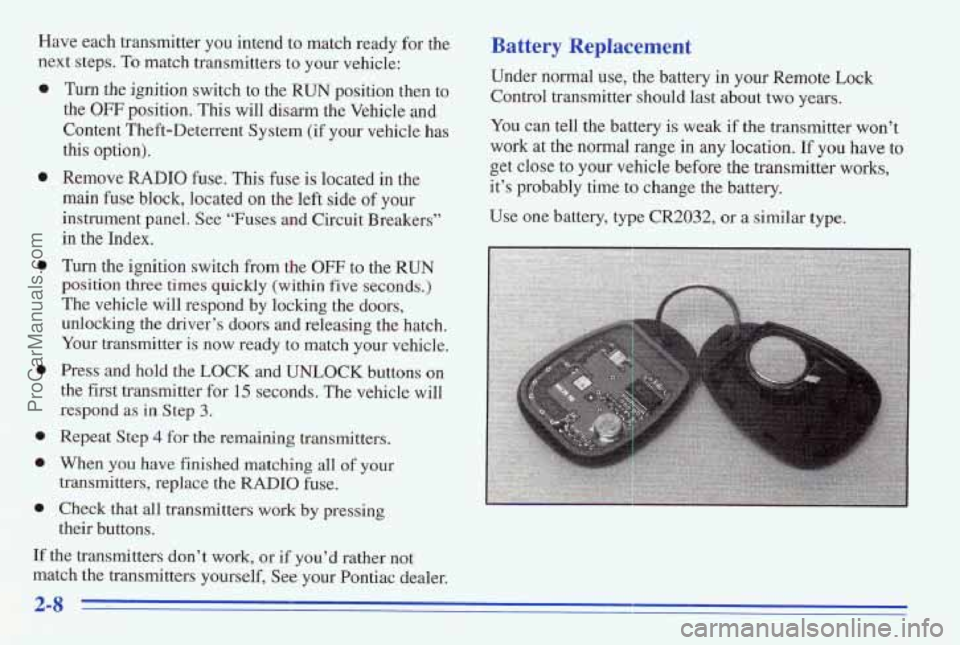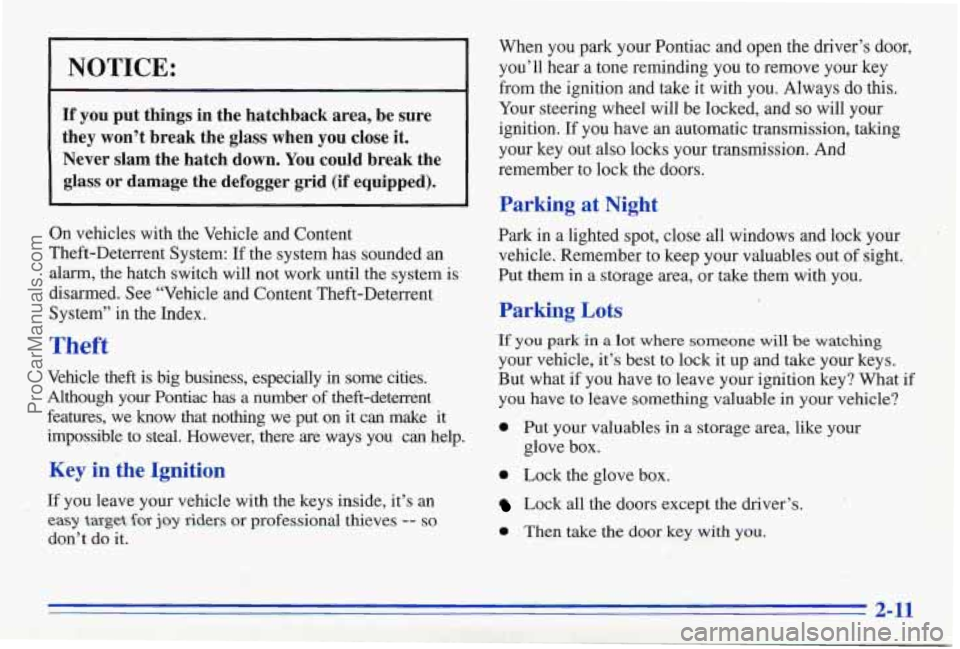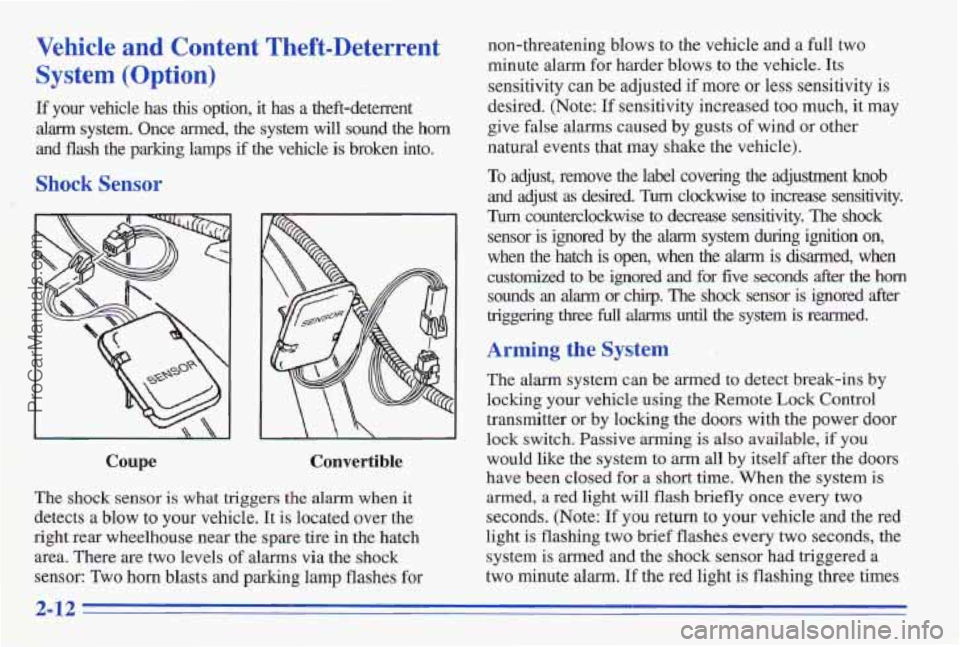ignition PONTIAC FIREBIRD 1996 Owners Manual
[x] Cancel search | Manufacturer: PONTIAC, Model Year: 1996, Model line: FIREBIRD, Model: PONTIAC FIREBIRD 1996Pages: 386, PDF Size: 19.18 MB
Page 32 of 386

0
0
Your vehicle is equipped with a crash sensing and
diagnostic module, which records information
about the air bag system.
The module records
information about the readiness of the system,
when the sensors are activated and driver’s safety
belt usage at deployment.
Let only qualified technicians work
on your air bag
system. Improper service can mean that your air
bag system won’t work properly. See your dealer
for service.
~~
NOTICE:
If you damage the cover for the driver’s or the
right front passenger’s air bag, they may not
work properly. You may have to replace the air
bag module in the steering wheel or both the
air
bag module and the instrument panel for the
right front passenger’s air bag.
Do not open or
break the air bag covers.
Servicing ,Your Air Bag-Equipped Pontiac
Air bags affect how your Pontiac should be serviced.
There are
parts of the air bag system in several places
around your vehicle. You don’t want the system to
inflate while someone is working on your vehicle. Your
Pontiac dealer and the Firebird Service
Manual have
information about servicing your vehicle and the air bag
system.
To purchase a service manual, see “Seririce and
Owner Publications” in the Index.
I A CAUTION:
II
For up to 10 minutes after the ignition key is
turned off and the battery is disconnected, an air
bag can still inflate during improper service. You
can be injured if you are close to an air bag when
it inflates. Avoid wires wrapped with yellow tape
or yellow connectors. They are probably part of
the
air bag system. Be sure to follow proper
service procedures, and make sure’ the person
performing work for you is qualified to do
so.
’he air bag system does not need regular maintenance.
ProCarManuals.com
Page 50 of 386

v Section 2 Features and Controls
Here you can learn about the many standard and
optional features on your Pontiac, and information on
starting, shifting and braking.
Also explained are the
instrument panel and the warning systems that tell you
if
everything is working properly -- and what to do if you
have a problem.
Keys
1
Leaving young children in'a vehicle with the
ignition key is dangerous for many reasons.
A child or others could be badly injured or
even killed.
They could operate power windows or other
controls or even make
the vehicle move. Don't
leave the keys in a vehicle
with young children.
I I
2-1
ProCarManuals.com
Page 51 of 386

The ignition keys are for the
ignition
only.
The door keys are for ,the
doors 'and
all other locks.
When a new 'Firebird is
delivered, the dealer
removes the plugs from the
'door ke.ys
and gives them to
the first owner. Each plug has
a code on it that
tells your dealer or a
qualified locksmith how to make extra door ,keys. Keep
the plugs in a safe place.
,If you lose your door keys,
you'll be able to have new ones made using these plugs.
If you need a new key, contact your Pontiac dealer who
can obtain the correct key code. Remember to carry the
pre-cut emergency key which Pontiac sends after
delivery.
In an emergency, call Pontiac Roadside
Assistance
at 1-800-ROADSDE or 1-800-762-3743.
NOTICE:
Your Pontiac has a number of new features that
can help prevent theft. But you can have a lot
of trouble getting into your vehicle if you ever
lock your keys imide. You may even have to
damage your vehicle to get h. So be sure you
have extra keys.
ProCarManuals.com
Page 53 of 386

Power Door Locks. (Option)
Push the power door lock
switch to lock or unlock
both doors at once.
Note: Operating the power door locks may affect the
Vehicle and Content Theft-Deterrent System
(if you
have this option). See “Vehicle and Content
Theft-Deterrent System” in the Index.
The lock switch works at all times. The unlock switch
only works when the ignition switch is in
RUN or ACC
or when RAP
is present. (See “Retained Accessory
Power” in the Index.)
East Door Closed Locking (Option)
If you have power door locks, you can program a last
door closed locking feature for your vehicle.
This
feature allows for a delayed. locking of the doors. This lets
you and your passengers exit
the vehicle after
you’ve pressed the power door lock switch. All
of the
doors will lock once everyone has gotten out of the
vehicle and closed their doors.
When
the power door lock switch is pressed, a chime
will
sound three times,.indicating that last door closed
locking has been activated. Pressing the LOCK switch
again will lo’ck
the doors immediately. Pressing the
UNLOCK switch will cancel a previously requested last
door closed loclung.
This feature
is shipped from the factory in the off
position. To turn this feature on, see “Feature
Custorrlization” in the Index.
Lockout Prevention (Option)
To protect you from locking your keys in the vehicle,
this feature stops the power door locks from locking
when the keys are in the ignition and a
door is open. If
the power lock switch is pressed when
a door is open, a
chime will sound five times as a reminder to take
the
keys out of the ignition before locking the door. This
feature is shipped from the factory in the on position. If
you would like to turn this feature off, see “Feature
Customization”
in the Index.
2-4
ProCarManuals.com
Page 55 of 386

peration
The driver’s door will unlock automatically when
UNLOCK is pressed. If UNLOCK is pressed again
within five seconds, the passenger door will also unlock.
All doors will lock when LOCK
is pressed.
The hatch will unlock when the button with the trunk
symbol is pressed, as long as the ignition is turned to the
OFF position. If the ignition is in the RUN position, the
trunk symbol button will only work if
the transmission
is in PARK (P) for an automatic transmission, or if the
parking brake is set on a manual transmission.
The system will turn on the interior lamps for about
40 seconds (or until the ignition switch is turned t’o the
RUN position), when you unlock the doors or hatch.
The interior lamps will
go off when you lock the doors.
Operating the Remote Lock Control transmitter may
interact with the Vehicle and Content Theft-Deterrent
System (if
you have this option). See “Vehicle and
Content Theft-Deterrent System”
in the Index.
Alarm/Panic Mode
If your vehicle is equipped with the Vehicle and Content
Theft-Deterrent System, you will have a fourth button on
your Remote
Lock Control transmitter. This button is the
panic button. If you
are involved in a panic situation,
press this button and your vehicle’s horn will sound and the parking lamps will flash. This will draw needed attention
to you
and your vehicle. To turn this feature off,
either push the panic button again or turn the ignition to
the RUN position. Note: This feature will not work if
your ignition is in the
RUN position or if the remote
transmitter is
30 feet or more away from your vehicle.
Transmitter Range
The range of your Remote Lock Control system should
be about
30 feet (9 m). At times you may notice a
decrease
in the range. This is normal for any Remote
Lock Control system. If the transmitter does not work,
or you have to stand closer to your vehicle than normal
for the transmitter to work:
0
0
0
0
0
0
You may have to replace the battery in your transmitter.
See
the instructions8 for battery replacement.
You may be too far from your vehicle. Check your
distance. You may have to stand closer
to your
vehicle in rain or snow.
Check the location. Other
vehicles or objects may be
blocking the signal. Take
a few steps to the right or left.
You may have
to synchronize your transmitter to the
receiver in your vehicle. See the instructions for
synchronization.
You may have to match the transmitters to your
vehicle. See instructions for matching transmitters.
If none of the above apply, see your dealer or
qualified technician for service.
2-6
ProCarManuals.com
Page 57 of 386

Have each transmitter you intend to match ready for the
next steps.
To match transmitters to your vehicle:
a
e
a
e
0
e
Turn the ignition switch to the RUN position then to
the OFF position. This will disarm the Vehicle and
Content Theft-Deterrent System (if your vehicle has
this option).
Remove
RADIO fuse. This fuse is located in the
main fuse block, located on the left side of your
instrument panel. See
“Fuses and Circuit Breakers”
in the Index.
Turn the ignition switch from the
OFF to the RUN
position three times quickly (within five seconds.)
The
vehicle will respond by locking the doors,
unlocking the driver’s
doors and releasing the hatch.
Your transmitter is now ready to match your vehicle.
Press
and hold the LOCK and UNLOCK buttons on
the first transmitter for 15 seconds. The vehicle will
respond
as in Step 3.
Repeat Step 4 for the remining transmitters.
When you have finished matching all
of your
transmitters, replace the
RADIO fuse.
Check that all transmitters work
by pressing
their buttons.
If the transmitters don’t work, or if you’d rather not
match the transmitters yourself, See your Pontiac dealer.
Battery Replacement
Under normal use, the battery in your Remote Lock
Control transmitter should last about
two years.
kou can tell the battery is weak if the transmitter won’t
work at
the normal range in any location. If you have to
get
close to your vehicle before the transmitter works,
it’s probably time to change the battery.
Use one battery, type CR2032, or a similar type.
ProCarManuals.com
Page 59 of 386

Hatch Release
Your door key opens the hatch.
If your vehicle has the Vehicle and Content
Theft-Deterrent System, and the system
is armed,
opening the hatch this way will trigger the alarm. First
&sarin the system or use the Remote Lock Control
transmitter to
open the hatch.
Remote Hatch Release (Option)
\
Press the switch under the lamp controls to unlock the
hatch
from inside y’our vehicle. If you have an automatic
transmission, your shift lever must be in
PARK (P)
or NEUTRAL (N) to use the switch. If you have a
manual transmission and the ignition switch is in
RUN, you must set the parking brake before you can
use the switch.
The switch only works when the ignition switch
is in
RUN or ACC, or when RAP is present. (See “Retained
Accessory Power” in the Index.)
ProCarManuals.com
Page 60 of 386

NOTICE:
If you put things in the hatchback area, be sure
they won’t break the glass when you close it.
Never slam the hatch down.
You could break the
glass
or damage the defogger grid (if equipped).
On vehicles with the Vehicle and Content
Theft-Deterrent System: If the system has sounded an
alarm, the hatch switch will not work until the system is
disarmed. See “Vehicle and Content Theft-Deterrent
System” in the Index.
Theft
Vehicle theft is big business, especially in some cities.
Although your Pontiac has a number
of theft-deterrent
features, we
know that nothing we put on it can make it
impossible to steal. However, there
are ways you can help.
Key in the Ignition
If you leave your vehicle with the keys inside, it’s an
easy tmget for joy riders or professional thieves -- so
don’t do it. When you
park your Pontiac and open the driver’s door,
you’ll hear a tone reminding
you to remove your key
from the ignition and take it with you.
Always do this.
Your steering wheel will be locked, and so will your
ignition. If you have an automatic transmission, taking
your key
out also locks your transmission. And
remember to lock the doors.
Parking at Night
Park in a lighted spot, close all windows and lock your
vehicle. Remember to keep your valuables out of sight,
Put them in a storage area,
or take them with you.
Parking Lots
If you park in a lot where someone will be watching
your vehicle, it’s best to lock it up and take your keys.
But what if you have to leave your ignition key? What
if
you have to leave something valuable in your vehicle?
0 Put your valuables in a storage area, like your
0 Lock the glove box.
Lock all the doors except the driver’s.
0 Then take the door key with you.
glove box.
2-11
ProCarManuals.com
Page 61 of 386

Vehicle and Content Theft-Deterrent
System (Option)
If your vehicle has ths option, it has a theft-deterrent
alarm system. Once armed, the system will sound the horn
and
flash the parking lamps if the vehicle is broken into.
Shock Sensor
I
Coupe Convertible
The shock sensor is what triggers the alarm when it
detects a blow to your vehicle. It is located over the
right rear wheelhouse near the
spare tire in the hatch
area. There are two levels of
alarrns via the shock
sensor: Two horn blasts and parlung lamp flashes for
non-threatening blows to the vehicle and a full two
minute alarm for harder blows to the vehicle. Its
sensitivity can be adjusted if more or less sensitivity is
desired. (Note: If sensitivity increased too much, it may
give false alarms caused
by gusts of wind or other
natural events that may shake the vehicle).
To adjust, remove the label covering the adjustment knob
and adjust as desired. Turn clockwise to increase sensitivity.
Turn counterclockwise to decrease sensitivity. The shock
sensor
is ignored by the alarm system during ignition on,
when the hatch is open, when the alarm is &arm& when
customized to
be ignored and for five seconds after the horn
sounds an alarm or chq. The shock sensor is ignored after
triggering
three fuu. alarms until the system is rearmed.
Arming the System
The alarm system can be armed to detect break-ins by
locking your vehicle using the Remote Lock Control
transmitter
or by lochng the doors with the power door
lock switch. Passive
arming is also available, if you
would
like the system to arm all by itself after the doors
have
been closed for a short time. When the system is
armed, a red light will flash briefly once every two
seconds. (Note: If you return to your vehicle and the red
light is
flashing two brief flashes every two seconds, the
system
is armed and the shock sensor had triggered a
two minute alarm. If the red light is flashing three times
2-12
ProCarManuals.com
Page 62 of 386

every two seconds, the system is armed and there was an
intrusion that sounded the alarm). Horn chirps and
parking lamp flashes can be set to your choice.
Remote Lock Control Transmitter Locking
If all the doors are closed, locking the vehicle with the
transmitter will immediately
arm the system. The horn
will chirp twice and the parking lamps will flash,
confirming that the system is armed.
If any door is open
when the transmitter LOCK button is pressed, the
system goes into an armed wait mode, waiting for the
doors to close. Once they are closed, the system will
arm, chirp the horns twice and flash the parking lamps.
If the hatch is open or ajar at the time the system is
arming, the horn will only chirp once.
Power Door Lock Switch Locking
If any door is open when the power door lock switch is
pressed, the system goes into
an armed wait mode,
waiting for the doors to close. Once they are closed, the
system will
arm and flash the parking lamps. If all of the
doors are closed when the lock switch is pressed, the
system assumes you are inside of the vehicle,
so it will
not
arm. Note: Locking the doors by using the manual
dm ‘Locks will not arm the system.
Passive Arming
If the ignition was just turned off and a door was
opened, the system will
arm six seconds after all doors
are closed, whether or not you lock them. In all other
cases, the system will wait
30 seconds after all doors are
closed before arming, allowing you time to get
into the
vehicle and the key in the ignition. The parking lamps
will flash when the system arms. Passive arming is not
enabled from the factory.
Disarming the System
There are two ways to disarm the system:
1. Press the UNLOCK button on the Remote Lock
Control transmitter.
If the horn chirps two or three
times when you unlock the car, the alarm sounded in
your absence.
lko chirps means that
the shock sensor was set
off and three chirps means
that a door or hatch was opened.
proper key.
2. Turn the ignition to the RUN position with the
For more information on customizing the features
mentioned here, see “Feature Customization” in
the Index.
2-13
ProCarManuals.com